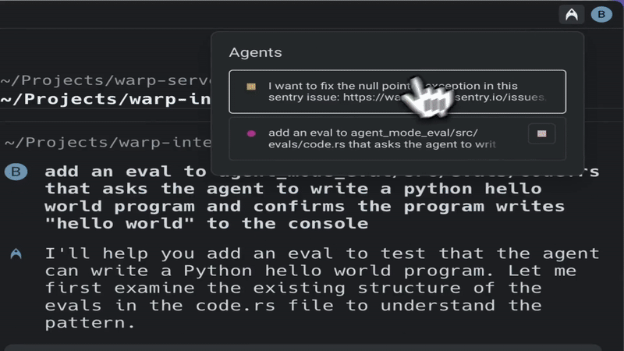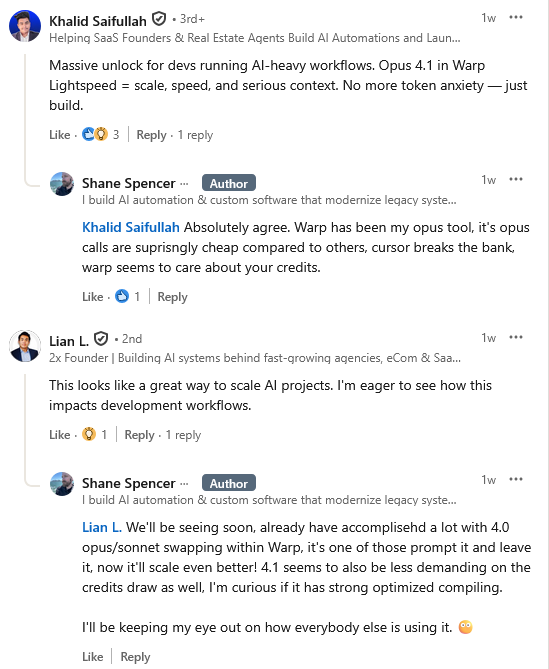
21 Aug 20256 minute read

21 Aug 20256 minute read

Warp, creators of a terminal-based agentic software development platform, is the latest company to revamp its pricing and plan structure.
The most notable change comes with the new Lightspeed plan, which offers five times the AI request capacity and significantly expanded codebase indexing limits.
In real terms, this equates to 50,000 AI requests per month, covering 40 indexed codebases with up to 100,000 files per codebase. That compares with 10,000 AI requests and 20,000 files per codebase on the plan beneath it.
On top of that, Warp has also cordoned off access to some of its top-tier AI models, including Claude 4 Opus, Claude 4 Sonnet, GPT-4.1, o4-mini, and Gemini 2.5, making them available exclusively to Lightspeed subscribers.
It’s worth noting that Warp doesn’t position itself in the same category as vibe-coding darlings like Cursor or Windsurf. Its focus is squarely on serious developers who live in the terminal and want deep, agentic automation rather than a full IDE experience. And for those pushing those workflows to the limit, either by maxing out request quotas or indexing gargantuan codebases, the new Lightspeed plan should go some way toward removing those bottlenecks.
“From debugging massive monorepos to running complex multi-agent workflows, developers are relying on Warp to power serious, production-grade work,” Warp CEO and founder Zach Lloyd wrote in a blog post.

However, Lightspeed represents part of a larger pricing overhaul from the folks at Warp, one that started a few months back. The company used to bundle unlimited monthly AI requests as part of its $40/month Turbo plan, but downgraded that to 3,000 requests per month, before bumping that figure back up to 10,000 requests in June. At the same time, Warp also boosted its $15/ month Pro plan from 1,000 to 2,500 AI requests.
Then on July 31, Warp quietly introduced a new Business plan at $55 per user per month, alongside the new Lightspeed offering.
Lloyd said that company has watched users increasingly push the limits of agentic development, with its most active developers frequently rubbing shoulders with monthly request quotas, codebase indexing caps, and hard stops.
“Over the past few months, we’ve seen Warp users push the boundaries of agentic development,” he wrote. “As usage has grown, so have the demands. While our Pro and Turbo plans work well for most developers, power users have consistently run into the same constraints: monthly request caps, indexing ceilings when working across large codebases, and hard stops that disrupt their workflows. Some even hit Turbo’s limits within just a few days.”
Reaction to the new Lightspeed plan has been overwhelmingly positive, with one developer noting the jump to 50,000 monthly requests, alongside the addition of Claude Opus 4.1, removed the token and request bottlenecks that previously slowed Warp’s agents, enabling faster iterations and more complex builds without juggling multiple APIs.
“If your agents were choking on token rations, today they breathe,” he wrote.
And that was the general consensus all round. The community praised Lightspeed as a “massive unlock” for AI-heavy workflows, calling Opus 4.1 in Warp a recipe for “scale, speed, and serious context” that all-but eliminates token anxiety.
Some also noted that Warp’s Opus calls are surprisingly affordable compared to competitors like Cursor.

In truth, Warp is one of many players in the AI coding space to overhaul their pricing structure of late, with the likes of Anthropic, Replit, and Cursor all fine-tuning their tiers and billing models these past few months.
But Warp is bucking a growing trend, as many rivals have shifted to usage-based or credit/token systems tied to compute costs. Such models can feel opaque, leaving developers guessing how far their allowance will stretch. By contrast, Warp’s pricing sticks to a clear request-count system, letting users know exactly how many AI calls they can make each month and making it far easier for individuals and teams to budget and plan their workloads.
“50K monthly requests at Lightspeed means developers can finally run instead of rationing API calls like scarce resources,” one commenter said.